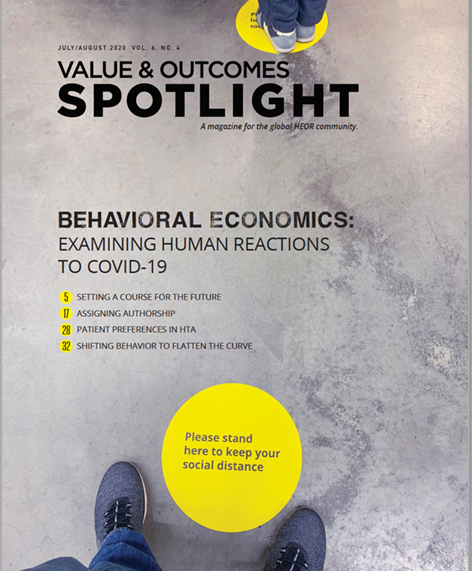Setting a Course for the Future in Our New Economic Reality
 I have assumed my role as President of ISPOR at the beginning of July, at a time when the daily number of people newly infected with COVID-19 has reached new highs, with more than 12 million people infected and more than half a million deaths globally. I want to thank you all for the trust that you put in me to lead ISPOR during these challenging times.
I have assumed my role as President of ISPOR at the beginning of July, at a time when the daily number of people newly infected with COVID-19 has reached new highs, with more than 12 million people infected and more than half a million deaths globally. I want to thank you all for the trust that you put in me to lead ISPOR during these challenging times.
I joined ISPOR in 1999, more than 20 years ago, as member #3201. That year, I started my new role as Head of Global Health Economics at Novartis. Diana Brixner, ISPOR President 2007-2008, was my colleague leading the Novartis US Health Economics team. Lou Garrison, ISPOR President 2016-2017, was leading health economics at Roche on the other side of the river, and Rob Epstein, who I collaborated with at Merck and Medco, was the ISPOR President at the beginning of that year. I was excited to be in the same company with all of these people and many more at ISPOR…it was my entrance to the global health economics and outcomes research (HEOR) community and connection to state-of-the-art HEOR methods.
"All of us coming together in ISPOR are passionate about informing better decisions to improve health outcomes for people around the world in a way that is financially sustainable."
I have attended all European ISPOR conferences and many US conferences in North America since then. I have seen these meetings grow from less than 1000 to over 5000 people. I liked the small meetings, where you could meet practically everyone who attended, and I have come to like the large meetings with their amazing spectrum of plenaries, methods sessions, issues panels, and workshops. I was proud to be elected to the Board of Directors from 2004-2006 and to be invited to speak in the plenary sessions in the 2009 and 2013 European meetings. I particularly enjoyed the work on the real-world evidence and performance-based risk-sharing agreements taskforces.
Today, ISPOR is more important and relevant to people in academia, industries, and healthcare than ever before. All of us coming together in ISPOR are passionate about informing better decisions to improve health outcomes for people around the world in a way that is financially sustainable. We are living in exciting and challenging times where science offers us previously unimaginable opportunities with cell and gene therapies, amazing diagnostic capabilities like molecular profiling and high-resolution imaging, and digital apps, and biomarkers. We realize that in order for health systems to pay for this, we need better information and rapid exchange of our perspectives and insights: new evidence, new methods, new models, new practices, and governance. And we need platforms where all stakeholders can come together.
COVID-19 is a turning point in how we value health and organize healthcare. In our ISPOR value flower (Figure), we have explicitly considered risk of contagion, which has been considered as a value element before, and fear of contagion as a new value element. At the same time, we realize that while the societal value of new therapeutics that prevent the spread and reduce the morbidity from the disease is huge, pharma companies will be expected to price their products substantially below that value given the financial constraints of countries.
We all agree how important it is to bring together real-time data and evidence in value-based healthcare systems that optimize for outcomes that are relevant for patients and for cost. We have seen changes in how societies accept and use digital tools to get better information and control of the spread of the disease. We have realized that we cannot optimize only for efficiency in a static way. Instead, we need to optimize the use of resources to drive innovation and eliminate redundancies to deal with catastrophic events.
We have all been working from home for many months, and we have become experts in using conferencing systems, online shops, and digital health services, including telehealth. We are at the beginning of a new era of working, communicating, and interacting with each other. Coming together in large events and conferences, like our ISPOR conferences, will remain important, but we will have more variety in how we come together that does not always require physical presence and travel.
"...we need to optimize the use of resources to drive innovation and eliminate redundancies to deal with catastrophic events."
When I wrote my vision statement to apply for the role of ISPOR President last year, I did not foresee COVID-19. I was focusing on 3 areas, all of which I believe are even more relevant now:
1. Ensure our HEOR methods and procedures are keeping pace with the move towards an increased people-centric focus on health and well-being, new and more complex healthcare technologies, and the availability of vast sources of digital data and advanced analytics. As we follow the science in understanding biology and diseases, we will discover more complex healthcare technologies that will increasingly combine diagnostics, preventive services, treatments, and outcome monitoring, targeting ever smaller patient populations in a much more personalized (sometimes even individualized way) to produce transformative outcomes for patients and potentially even avoid/cure diseases. While our value frameworks and evidence tools are flexible and cover a broad range of perspectives and data sources, their application and interpretation require new tools and approaches. In addition, we will see HEOR increasingly being applied at a systems level, specifically in the context of value-based healthcare and value-based insurance design. This will be facilitated by better availability, quality, and interoperability of real-world data—from electronic health records, hospital information, pharmacy, and lab systems all the way to sensors and wearables
2. Take a truly global perspective to ensure that HEOR information leads to better decisions about healthcare, in particular as we see a shift in developing economies around the world towards noncommunicable diseases that require new capabilities and more capacity in HEOR and HTA. We will have to find ways to make HEOR and HTA more efficient, fostering collaboration and sharing of work between authorities, avoiding duplication and providing high-quality competent input in capacity-constrained environments. At the same time, it needs to be tailored to the respective health systems and health problems and integrated into the broader policy context and priorities.
3. Strengthening our leadership pipeline and providing a clear path for the talented people that come to ISPOR to engage in the society and become the future leaders of this organization. Many of you have already contacted me and expressed your interest in serving the society more. In my time on the Nominations Committee, I observed that we do not have broad visibility of all the people that are already working in our various committees, chapters, and interest groups, and we can do better in coaching and guiding our younger colleagues on how they can engage and grow in the organization.
I hope these goals resonate with you, and I am optimistic and committed to make tangible progress on each of these over the next 12 months.
Of course, on top of this, I will work closely with CEO Nancy Berg, the ISPOR staff, the Board of Directors, and the Past Presidents Council to make sure that ISPOR continues on a promising path that adapts to the new realities of scientific societies and conferences in times of the pandemic, using digital technologies in a much more profound way and ensuring a positive financial outlook for the society.
Thank you again for your trust and support, and all the best to you and your families. Stay healthy.
Note. Green circles: core elements of value; light blue circles: common but inconsistently used elements of value; dark blue circles: potential novel elements of value; blue line: value element included in traditional payer or health plan perspective; and red line: value element also included in societal perspective. [Source: Defining Elements of Value in Health Care—A Health Economics Approach: An ISPOR Special Task Force Report [3]. Value Health. 2018;21(2):131-139.]

